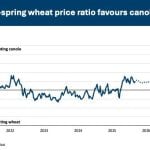Looking for just the right breed for grass-fed beef?
There’s one place where the type of cattle that thrive on a forage-only diet can be found in abundance – in sales catalogues from 1957, said Todd Churchill, a rancher and grass-fed beef marketer from Cannon Falls, Minnesota.
As the buyer for Thousand Hills Cattle Co., which he founded in 2003, he travels widely. Recently, a rancher showed him a copy of the sales catalogue issued by the Shorthorn Association more than five decades ago.
“There’s rows of pictures of Shorthorn steers that are short, 1,200 pounds and fattened entirely on grass at 18 months,” said Churchill.
Read Also

Beef cattle more prone to trace mineral deficiencies
The trace mineral status of our cows and calves is a significant challenge for western Canadian producers and veterinarians.
“That’s what I want. Unfortunately, those kinds of cattle don’t exist anywhere in the world today.”
Smaller frame, easy-keeping cattle popular in the 1950s, such as Shorthorns, fell out of favour with the rise of feedlots and grain-based finishing in the 1960s, he added.
When the easy-keeping cattle that dominated the U.S. and Canadian herds were put on a “Krispy Kreme donut diet,” they got too fat, and the packers complained about all the waste they had to throw away.
“We know from historical records that British breed cattle were selected over thousands of years by expert stockmen to produce fine quality meat and milk,” he said.
“The Continental cattle that we introduced in the last 40 years, for the most part those breeds go back to oxen. You want something very different in an ox than a beef cow.”
As better agronomic practices produced mountains of cheap feed grain, the market decided that the ideal feedlot animal was a cross between the easy-fleshing, fine muscle textured, fattier British breed and the Continental breeds of Charolais, Tarentaise, Limousin, Gelbvieh and Simmental, he said.
“Those cattle for thousands of years had been selected for pulling as oxen. What do you want in an ox? You want a large frame, late maturing because early maturing cattle don’t get as big, and you want a lot of sinew and tendon to hold that skeleton together. When you cross those two together, you get an optimal animal for harvesting its feed out of a feed bunk.”
Such genetics have been sneaking into the British breeds, he added, as breeders stopped culling the oddballs that showed up periodically: the tall, slow maturing animals.
“Now, even when I go look at purebred Angus herds, they look like crossbred cattle,” he said.
“Why do I find that I only like two to five percent of the cattle in this country? That’s because the market has dictated that everybody raise cattle that are optimized for a feedlot.”
As a marketer, Chur-chill’s fortunes depend on whether he can choose cattle that provide the best carcass yield possible. When he started in 2003, the best he could achieve was a meat-to-bone ratio of around 61 percent. Now, with a better-trained eye, he has boosted that number to 65 percent salable product.
He looks for steers that will dress out at 550 to 800 lb., with optimal weights of 600 to 700.
Typically they are shorter, thicker, deeper, well muscled, with small dense cannon bones.
Small, refined knee and hock joints indicate fine muscle texture and less connective tissue – or gristle, in diner’s terms.
He’s not aiming for lean beef. All the animals he buys must have an acceptable finish, which means a full brisket, no ribs showing, cod fat on a steer and udder fat on a heifer.
“I don’t care what age they are. But, because of customer misconceptions about BSE, I have to cap it at 30 months,” he said, adding that it’s only government regulations that prevent sales of bone-in cuts from older animals.
“I have seen no difference in tenderness or meat quality from an 18-month-old animal to 30 months.”














